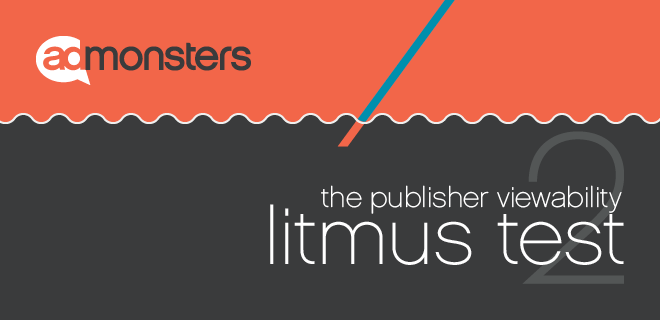
Download the latest Publisher Viewability Litmus Test here. (Note: You must log in or register with AdMonsters to download the survey.)
From the Executive Summary:
In April 2014, shortly after the Media Rating Council lifted its embargo on transacting display inventory on a viewability basis, AdMonsters fired out a survey to its base of digital revenue specialists. The responses formed the basis of our inaugural Publisher Viewability Litmus Test (VLT), a report we planned on updating six months later, especially since all signs pointed to the fourth quarter of 2014 opening the floodgates of viewability RFPs.
In December that year, IAB piggybacked on an MRC assertion and declared that 100% viewability is “unreasonable” at the moment. Despite a reconciliation process mandated for keeping vendor MRC certification, wide variability in viewability reporting (sometimes between 30% to 40%) persists between providers. There are also concerns that many providers cannot measure all impressions (viewable or not) served in a campaign, a situation referred to as “dark viewability.” The IAB determined that a 70% viewability threshold was more fair, a benchmark in line with what AdMonsters has heard from publishers.
This announcement came in the wake of a now-infamous GroupM email demanding 100% viewability from all publisher partners – at the November IAB Ad Ops Summit, GroupM Chief Digital Officer Rob Norman suggested this was a negotiation tactic, a shot off the bow if you will. But several publishers are actually inking 100% viewability deals; the IAB’s “unreasonable” ruling was also refuted by the 4A’s in an email to its members.
In VLT part deux, many publishers reported that agencies are expecting 100% viewability when it’s simply not feasible – 47% said that some contracts received demanded to pay only for viewable impressions, while 9% said half of all contracts and 12% quoted the majority. We’ve heard from many publishers that their agency counterparts are less knowledgeable about the technology and process, including lacking awareness of which vendors are MRC-certified and for what.
Confusion about how to transact on viewability could explain why fourth quarter 2014 did not herald the inundation of viewability-based contracts we were expecting. Half of the publishers have seen a small increase in the use of viewability measurement within the last few months, while 39% reported a larger jump. But when asked how many contracts were regularly coming through with viewability terms and conditions, 58% of respondents said some, 12% said half and only 9% said the majority of contracts. No respondent was seeing viewability demands on every contract and 21% actually weren’t seeing any at all.
Despite extensive testing and preparation (changing ad positions, lazy loading, sticky ads, etc.) nearly half of the publishers surveyed have yet to execute a viewability campaign. About 22% of the publishers have decided at this point not to sell products based on viewability.
Nearly a year after the embargo was lifted, many of the same issues linger – particularly variance in provider numbers. Despite the immaturity of the space, the VLT shows that publishers are making the most of viewability tools to improve their sites, develop higher performing ad units and further learn about their audiences. But exactly how to transact on viewability – be it with thresholds or 100% in-view similar to TV demo deals – is not clear, and appears to stalling progress alongside a lack of education.
Download the latest Publisher Viewability Litmus Test here.